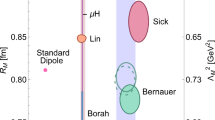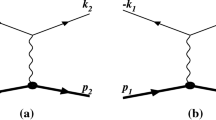Abstract
The kinematical difference between the description of radiative effects for fixed \(Q^2\) vs a fixed scattering angle in the elastic lepton–proton (lp)-scattering is discussed. The technique of calculation as well as explicit expressions for radiative corrections to the lepton current in unpolarized elastic lp-scattering for these two cases are presented without using an ultrarelativistic approximation. A comparative numerical analysis within kinematic conditions of Jefferson Lab measurements and MUSE experiment in PSI is performed.





Similar content being viewed by others
Data Availability Statement
This manuscript has no associated data or the data will not be deposited. [Authors’ comment: The discussion presented in this article develops from already existing and published data which are duly referenced.]
References
L. Andivahis et al., Phys. Rev. D 50, 5491 (1994)
I.A. Qattan et al., Phys. Rev. Lett. 94, 142301 (2005)
M.K. Jones et al., Jefferson Lab Hall A Phys. Rev. Lett. 84, 1398 (2000)
O. Gayou et al., Jefferson Lab Hall A Phys. Rev. Lett. 88, 092301 (2002)
P.J. Mohr, B.N. Taylor, D.B. Newell, Rev. Mod. Phys. 80, 633 (2008)
I. Sick, Phys. Lett. B 576, 62 (2003)
R. Pohl et al., Nature 466, 213 (2010)
W. Xiong et al., Nature 575, 147 (2019)
A. Accardi, et al. Eur. Phys. J. A 57, 8 (2021)
A. Afanasev, P.G. Blunden, D. Hasell, B.A. Raue, Prog. Part. Nucl. Phys. 95, 245–278 (2017)
R. Gilman et al. (MUSE). arXiv:1709.09753
A. Gasparian et al. (PRad). arXiv:2009.10510
N. Kaiser, J. Phys. G 37, 115005 (2010)
M. Vanderhaeghen et al., Phys. Rev. C 62, 025501 (2000)
L.W. Mo, Y.S. Tsai, Rev. Mod. Phys. 41, 205 (1969)
D.Y. Bardin, N.M. Shumeiko, Nucl. Phys. B 127, 242 (1977)
I. Akushevich, H. Gao, A. Ilyichev, M. Meziane, Eur. Phys. J. A 51, 1 (2015)
R.D. Bucoveanu, H. Spiesberger, Eur. Phys. J. A 55, 57 (2019)
P. Banerjee, T. Engel, A. Signer, Y. Ulrich, SciPost Phys. 9, 027 (2020)
D. Adikaram, et al., CLAS, Phys. Rev. Lett. 114, 062003 (2015)
D. Rimal, et al. (CLAS), Phys. Rev. C 95(6), 065201 (2017)
A. Afanasev, I. Akushevich, N. Merenkov, Phys. Rev. D 64, 113009 (2001)
I. Akushevich, A. Ilyichev, Phys. Rev. D 100(3), 033005 (2019)
A. Afanasev, A. Ilyichev. arXiv:2007.02087
B. Adams, et al. (COMPASS++/AMBER), CERN-SPSC-2019-022; SPSC-P-360. http://cds.cern.ch/record/2676885. Accessed 20 May 2021
A.V. Afanasev, I. Akushevich, A. Ilyichev, B. Niczyporuk, Czech. J. Phys. 53, B449–B454 (2003). arXiv:hep-ph/0308106
I. Akushevich, O.F. Filoti, A.N. Ilyichev, N. Shumeiko, Comput. Phys. Commun. 183, 1448–1467 (2012)
G. ’t Hooft, M.J.G. Veltman, Nucl. Phys. B 153, 365–401 (1979)
Acknowledgements
The authors thank the anonymous referee of this paper for insightful comments.
Author information
Authors and Affiliations
Corresponding author
Additional information
Communicated by Nicolas Alamanos.
Appendices
Appendix A: Calculation of \(\delta _S\) and \(\delta _H\)
For calculation of \(\delta _S\) in the dimensional regularization
where \(x=\cos \theta \) (\(\theta \) is defined as the spatial angle between the photon three-momentum and \(\mathbf{k}^\prime _i \) (\(i=1-3\)) that are introduced below) and \(\mu \) is an arbitrary parameter of the dimension of a mass the reference system \(\mathbf{p}_1+\mathbf{q}=\mathbf{0}\) is used.
The Feynman parameterization of (59) gives
Here \(\beta _i=|\mathbf{k^\prime }_i|/k^\prime _{i0}\) for \(i=1,2,3\) and \(k_3=y k_1+(1-y)k_2\).
After the substitution of Eqs. (A.1) and (A.2) into the definition of \(\delta _S\) by Eq. (62) and, using \(\delta \)-function, integrated over the photon energy \(k_0\) one can find that
The integration over v and the expansion of the obtained expression into the Laurent series around \(n=4\) result in
where
and
Here \(P_{IR}\) is the infrared divergent term defined by Eq. (43). Taking into account that \(k_3^2=y(1-y)Q^2+m^2\) the integration over x and y variables in \(\delta _S^{IR}\) is simple:
where \(J_0\) is defined by Eq. (42).
For the calculation of \(\delta _S^1\) we note that in the system \(\mathbf{p}_1+\mathbf{q}=\mathbf{0}\) the energies of the initial and scattering lepton through the invariants:
As a result,
where
and
Notice that the standard expressions for \(S_\phi \) are rather cumbersome, see for example Eqs. (35) and (A.14) of work [17]. In Appendix B we present a more compact analytical expression for this quantity.
For the calculation of \(\delta _H\) the straightforward integration is used. Taking into account (60), one can find that
Appendix B: Calculation of \(S_\phi \)
Here we present a general approach suggested by ’t Hooft and Veltman in their work [28] for a compact representation of the \(S_\phi \)-function introduced by Bardin and Shumeiko in [16]. Let us consider a real photon with a momentum k and three other time-like four-momenta \(a_i\) (\(i=1,2,3\)) with masses \(m_i^2=a_i^2\). The basic idea consists in Feynman parameterization. Instead of usual approach used in the standard Bardin-Shumeiko technique with two fermionic propagator presented in previous appendix, taken in the system \(\mathbf{a}_3=0\):
Here, as in the previous appendix \(x=\cos \theta \), a new four-vector \(a_4=y a_1+(1-y)\gamma a_2\), and \(\beta =|\mathbf{a}_4|/a_{40}\). The quantity \(\gamma \) is choosing in such a way, that \((a_1-\gamma a_2)^2=0\), i.e. \(a_1-\gamma a_2\) is lightlike vector.
Now introduce the following invariants:
Then equation \((a_1-\gamma a_2)^2=0\) has the following two solutions:
and the generalized form of \(S_\phi \) looks as (A.11):
The first integration over x is straightforward
where \(m_4^2=a_4^2=ym_1^2+(1-y)\gamma ^2 m_2^2\). The second integration has to be performed after the standard substitutions, while taking into account that for the first two momenta \(a_{i0}=s_i/(2m_3)\).
Finally, we can find that for the general case \(S_\phi \) depends on six variables and for \(\gamma =\gamma _1\) it has the following structure:
where \(\rho =(2s_1(s_3+\sqrt{\lambda _3})-4m_1^2s_2)/\sqrt{\lambda _3} \).
It should be noted that
The r.h.s. of this equation corresponds \(\gamma =\gamma _2\).
In our case \(a_1=k_1\), \(a_2=k_2\), \(a_3=p_2\), and \(s_1=X\), \(s_2=S\), \(s_3=Q^2+2m^2\), \(m_1=m_2=m\), \(m_3=M\).
Rights and permissions
About this article
Cite this article
Afanasev, A., Ilyichev, A. Radiative corrections to the lepton current in unpolarized elastic lp-interaction for fixed \(Q^2\) and scattering angle. Eur. Phys. J. A 57, 280 (2021). https://doi.org/10.1140/epja/s10050-021-00582-w
Received:
Accepted:
Published:
DOI: https://doi.org/10.1140/epja/s10050-021-00582-w




